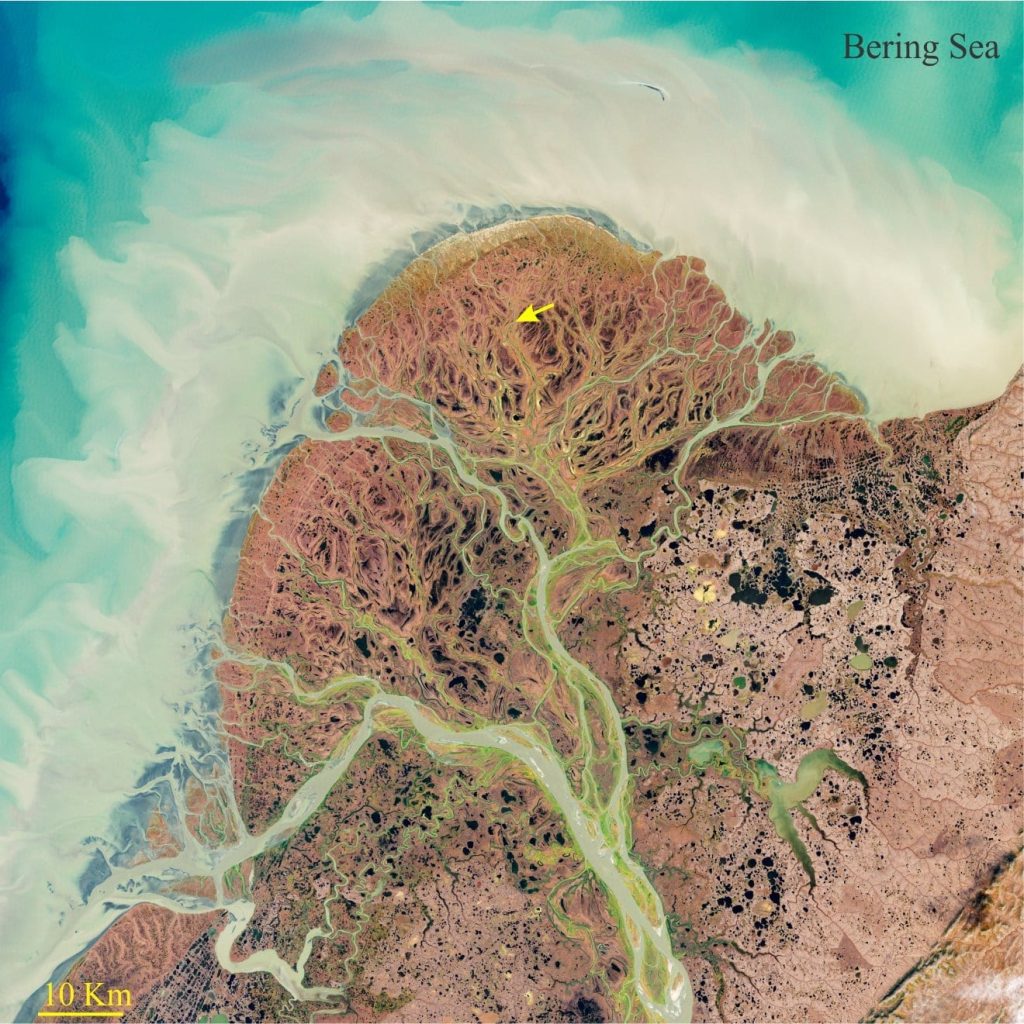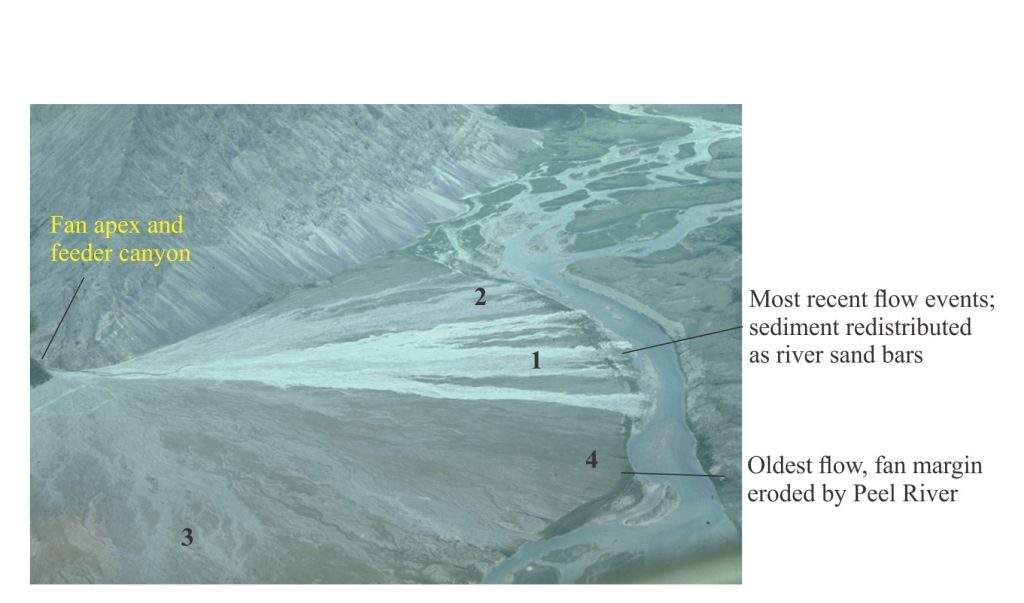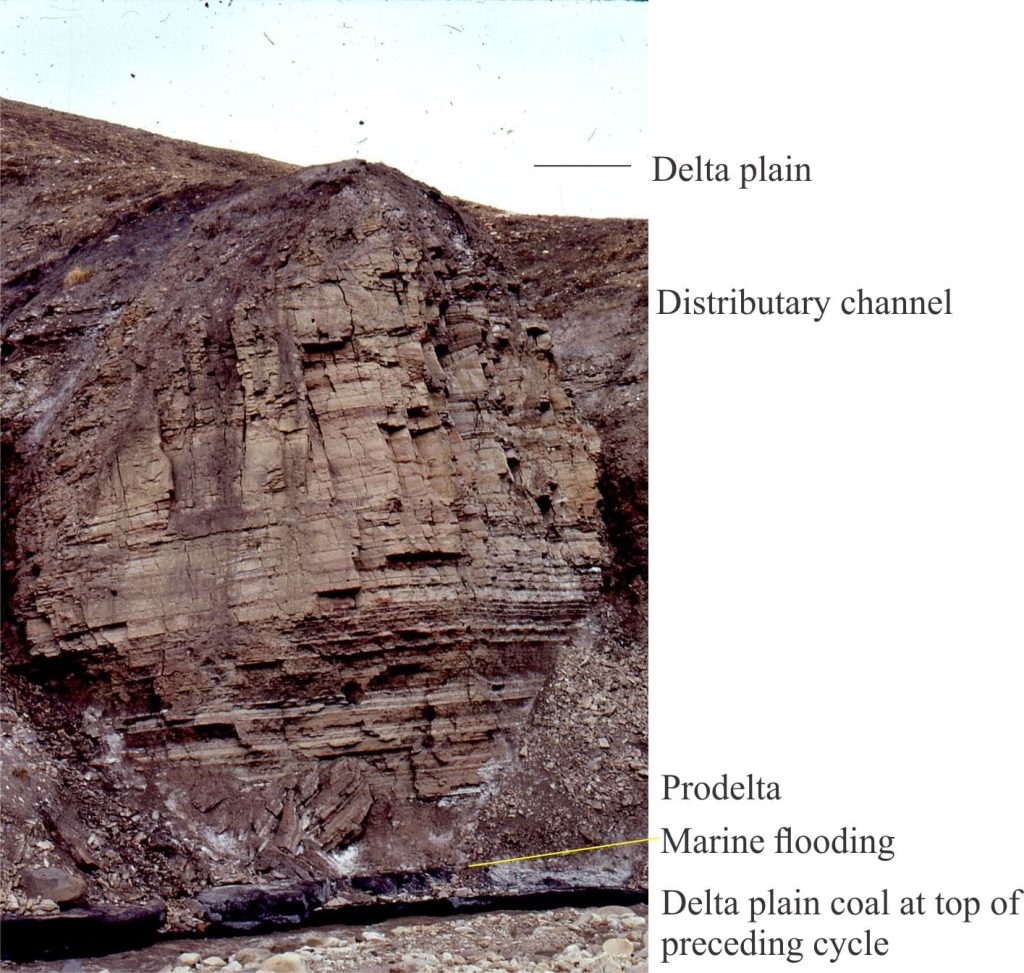

Braided gravel river draining into Canon Fiord, Ellesmere Island; autogenic storage and release from channel bars and the river mouth fan delta
Or why the distinction between allogenic and autogenic dynamics is not as straight forward as we might think!
Stratigraphic analysis projects windows of opportunity. It allows us to decipher ancient environments and the conditions under which sediments accumulate – in fact we spend a great deal of time doing this. But stratigraphy offers much more – it also presents us with windows into the kinds of processes that influence, at a grand scale, entire sedimentary basins and global events. Wrapped-up in the stratigraphic successions we observe are signals of past eustatic sea level fluctuations, climate change, tectonic plate reorganizations, and evolutionary events. We know that these signals are present, but the problem we face attempting to tease them from the rock record, is making the distinction between these external processes and the processes that govern sediment accumulation at more local, internal scales.
A typical example of this conundrum is contained in the outcrop-scale example below, that shows a coarsening- and shallowing-upward delta-lobe succession overlying a coal bed (marsh, delta plain). This unit is in turn overlain by another shallowing-upward cycle having similar thickness and facies. The base of each cycle begins with muddy prodelta deposits that overlie thin coal beds, indicating that each was heralded by marine-brackish flooding of the delta plain; i.e. a significant change in relative sea level that drove a landward migration of the shoreline. As deposition progressed, the delta front migrated seawards. The delta lobe was subsequently abandoned and eventually flooded, whereupon the cyclic process began anew. This switching of delta lobes is a well-known phenomenon in modern river-dominated deltas (e.g. Mississippi delta).


Schematic diagram showing successive delta lobes as the autogenic response to geomorphic gradients, and sediment storage and release in different components of the river-distributary channel, and delta lobe system . Figure modified from Nichols, 2009, Figure 12.16. Compare this schematic with the Landsat image below of Yukon Delta.


Northern part of the Yukon-Kuskokwim River Delta; this segment is drained by Yukon River. The main distributary channel as of 2002 drains lower left; minor channels drain north. Inactive, abandoned channels and delta lobes (pale brown hues) abound on the delta plains (yellow arrow). The delta drains into Bering Sea. LANDSAT 7, NASA Earth Observatory image created by Jesse Allen and Robert Simmon https://earthobservatory.nasa.gov/images/72762/yukon-delta-alaska
We can think of delta lobe switching as the sum of three important conditions: a change in the location of the delta front (a bit like shoreline migration), a change in the locus of sediment supply, and depletion and renewal of sediment accommodation. What processes controlled these lobe switching events? We can simplify this problem by asking two fundamental questions:
- Was switching controlled by processes interacting within the delta lobe setting? We refer to these ‘internal’ processes as Autogenic, or
- Were the changes controlled by processes acting outside the delta depositional system? Such processes might include subsidence at the site of deposition, tectonics in sediment source areas (e.g. mountain building and erosion), climate, and eustatic sea level fluctuations. We refer to these as Allogenic
The rationale for distinguishing between autogenic and allogenic dynamics was first discussed by Beerbower (1964 – he introduced the terms autocyclic and allocyclic).
He used the various depositional components of fluvial systems (channels, crevasse splays, floodplains) to argue that deposition and erosion occurred spontaneously, controlled by local gradients in potential energy (for example depositional slopes, and gravity induced hydraulic gradients), and the various thresholds that govern sediment transport. Beerbower understood that these internal processes, deployed at local scales, are responsible for generating the fining upward stratigraphic trends that are characteristic of meandering river systems.
In a very tidy reminder, Stanley Schumm (1973, 1979), in yet another classic contribution, pointed us in the direction of internal threshold conditions that influence sediment transport and deposition: e.g. initiation of sediment movement, flow regime, and the migration or avulsion of fluvial channels (reminding us of Beerbower’s contribution) – all of these processes act spontaneously in depositional systems and are capable of generating stratigraphy. His concept of geomorphic threshold is important in this context – the concept refers to geomorphic processes, but these processes have stratigraphic consequences. A commonly cited example of a threshold involves fluvial-alluvial channels that aggrade, where deposition gradually reduces the local gradient relative to adjacent parts of the system; at some critical point the active channel will migrate or avulse laterally to a steeper part of the system because of the advantage of higher gravitational potential energy. Such processes have also been observed in delta lobes and alluvial fans. Physical experiments, that create microcosm-like analogues of real depositional systems, have also been highly successful in helping recognize the processes and controls on autogenic dynamics – despite the problems of scale that are inherent to such investigations (for example, scaling geological time, sedimentation rates, and sediment particle size). Elegant reviews of this approach to the problem can be read in Paola (2016) and Paola et al.(2009). Recent numerical modelling has also presented the possibility of submarine fan lobe (autogenic) switching, in the absence of allogenic signals such as source area tectonics and sea level change (Burgess et al, 2019).
Alluvial fans provide useful examples of the role of geomorphic thresholds – in the image below we can distinguish the most recently active channel from older channels, where each migration event was determined by an advantage in topographic gradient. Each autogenic channel migration or avulsion event is potentially recorded by stratigraphy.


Autogenic avulsion and migration of active channels on a small alluvial fan, controlled by evolving geomorphic gradients, Peel River, Yukon
These thresholds, plus the change in locus of sediment transport on alluvial fans, like that with the migration or avulsion of fluvial channels, are united by what Paola (2016) refers to as the unifying theme of sediment storage and release in autogenic systems. For the alluvial fan described above, sediment in the elevated and subsequently abandoned fan segment remains in storage while sediment in the currently active channels is moved towards the trunk river (where it too will be temporarily stored and released from mid-channel sand-gravel bars). The mechanisms of storage ( deposition) and release (erosion) are autogenic. Storage and release of sediment acts at a range of scales in time and space. Again, physical experiments involving fluvial-dominated analogues for channels, deltas, and alluvial fans, can control and measure critical variables like sediment flux, sediment-body geometry, and sediment mass balance among different components of the modelled system (such as channels, levees, floodplains, and active and inactive fan or delta lobes). Measured rates or fluxes can then be scaled to real-world depositional settings.
Autogenic processes “can produce depositional patterns similar to those associated with climate, tectonic, or sea level changes” (Hajek and Straub, 2017). The traditional approach to making the distinction between autogenic and allogenic dynamics, an approach espoused by Beerbower, is that depositional trends and their accompanying stratigraphic successions at time scales >105 years are controlled by the kinds of long-term allogenic processes noted above; those of brief duration, extending over years to 104 years are more likely to be autogenic. However, more recent analysis, in part guided by physical and numerical experiments, demonstrates that autogenic processes may have time scales extending to a million years (106) and more (Paola, 2016). Thus, the overlap in time scales leaves a substantial ‘grey zone’ where the distinction between autogenic and allogenic is less obvious.
Such distinctions become even more complicated when we acknowledge that there is always some interaction between the two, within any time frame. Delta lobe switching may involve spontaneous, internal processes but it occurs within a more general framework of regional sediment supply (e.g. source area uplift, climate- controlled erosion) and fluctuating sea levels. Likewise, channel avulsion or migration on alluvial fans may be controlled by evolving geomorphology, but the supply of sediment is determined by regional topography, climate, and the size of the adjacent drainage basin. Furthermore, autogenic processes may erase the allogenic contributions, and allogenic processes mask those of autogenic origin (Paola, 2016).
Differentiation of autogenic and allogenic system dynamics seems at first thought to be reasonably straight forward. Except that it isn’t. Unravelling the relative contributions of each set of processes is a challenge for stratigraphy, and continues to be a source of innovative experimentation and modelling. This is not a trivial problem, because it lies at the heart of such tasks as teasing global eustatic sea level signals from local, relative sea level fluctuations.
Other posts in this series on Stratigraphy and Sequence Stratigraphy
Stratigraphic surfaces in outcrop – baselevel fall
Stratigraphic surfaces in outcrop – baselevel rise
A timeline of stratigraphic principles; 15th to 18th C
A timeline of stratigraphic principles; 19th C to 1950
A timeline of stratigraphic principles; 1950-1977
Baselevel, Base-level, and Base level
Sediment accommodation and supply
Stratigraphic cycles: What are they?
Sequence stratigraphic surfaces
Shorelines and shoreline trajectories
Stratigraphic trends and stacking patterns
Stratigraphic condensation – condensed sections
Depositional systems and systems tracts
Which sequence stratigraphic model is that?
Beach microcosms as analogues for fan deltas
References: These are linked in the text.
Here are a couple of links to movies of experimental flows in rivers, deltas and alluvial fans:
Two experiments showing evolution of braided and meandering river channels, by W. van Dijk
This site has links to several experiments and movies, developed by Chris Paola and colleagues at St. Anthony Falls Laboratory, University of Minnesota.

